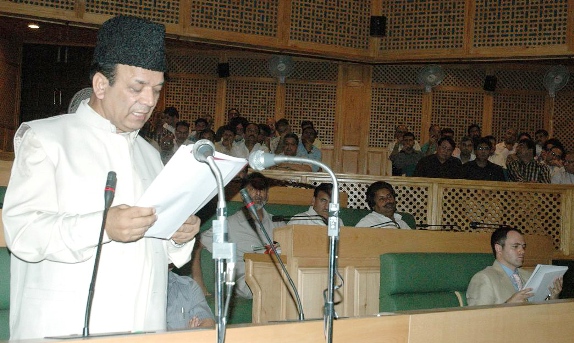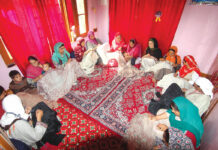
We must recognize that the biggest challenge before us is to boost our economic activities to catch up with national growth rate and per capita income.
We must control large scale flight of capital for mass procurement of a wide variety of consumption goods such as food grains, pulses, spices, oils, mutton, poultry, eggs, processed food, clothing, energy, building materials and other utility items. For this purpose, we must focus our energies and resources on increasing local production and thus expanding the employment base by improving our productivity, profitability and competitiveness. We intend to adopt a cluster approach in order to concentrate our resources on such clusters and obtain quicker results. In all important fields, private participation shall not only be encouraged but also pro-actively promoted.
Agriculture & Allied Sectors
Though the Primary Sector’s contribution in the GSDP has slipped down to 26%, its importance cannot be over-emphasized as it sustains 75% of our rural population and 50 % of our work force. The main areas of concern are low Seed Replacement Rate, inadequate double cropping and sub-optimal use of other inputs.
A large part of agricultural areas of the state including Kashmir Valley have been traditionally presumed to be single crop areas. Even crops like mustards, oilseeds and fodders have not drawn 100% attention of the farmers in double cropping. SKUAST, Kashmir has developed varieties of wheat seed to suit such climate and introduced a new ‘rice-wheat rotation’ technique. For the forthcoming Rabi season, the government shall focus on popularizing this programme. Availability of manpower and pressure on time of successive agricultural operations prove to be important constraints against double cropping. Accordingly, the government has proposed 25% subsidy on the cost of power thrashers and paddy transplanters under Agriculture Farm Mechanization Scheme to effectively deal with these twin problems.
Irrigation Schemes
It is proposed to complete all the on going minor irrigation schemes within the current financial year and latest during the next year for which full funding shall be provided. The work on ongoing major medium schemes has also to be accelerated and shall be closely monitored.
Horticulture
In respect of the Horticulture sector, the current year’s proposed outlay is Rs.13.82 crore in comparison to Rs.12.65 crore allocated last year. The department will substantially increase the availability of high density plantation material over its present level of nearly 2 lakh saplings per annum by involving private sector and ensuring quality control. Use of sprinkler, drip and root irrigation techniques, sound health care and better farm management shall be encouraged. Post harvesting facilities, grading and packing shall be improved. Offers stand invited through APEDA for engaging a consultant for establishing CA stores and cold chain in our State. Production of apricots in Kargil & Leh, cherries, strawberries, plums in Kashmir Valley and other regions with similar agro climatic conditions, olive in Uri and Ramban areas, pears in the Districts of Poonch and Rajouri and other areas having similar agro climatical conditions, sub-tropical fruits in the areas of Jammu Division and cultivation of minor fruit crops in the wastelands and Kandi areas shall be given priority. Production of saffron, siyah zeera, aromatic plants and herbs shall be given the much needed boost. Agriculture Production Department and Planning Department shall arrange to carry out economic analysis of various commercial operations to determine their sustainability and to identify the areas where additional government support is required. A cluster approach shall be adopted for expanding production and improving productivity.
Commercial Floriculture, an upcoming area
Over 840 growers have been registered by the Floriculture Department, each having green house facilities of at least 2 kanals. A good beginning has been made by these registered growers by selling flowers in the markets outside the state. The government shall actively and financially help them to explore the export market in the Middle East by taking advantage of international air port at Srinagar.
The Airport Authority of India has conveyed no objection to the transfer of land to the Directorate of Floriculture for setting up of cooling chambers. Request has been made to APEDA to provide necessary financial support to start work on this project which will help in exports of perishable commodities like cut flowers, delicate fresh fruits and trout fish to important marketing destinations within and outside the country.
Sericulture Industry
Sericulture has been an important traditional industry of Jammu and Kashmir. Kashmir Silk was always rated as of the best quality. Like many other misfortunes, immediately after demonopolisation of the industry around the year 1988-89, it was severely damaged during the period of militancy. After its partial revival, the industry still sustains about 22000 rural families in 2150 villages producing 8 lakh kgs of cocoons valued at nearly Rs.7 cr. The local silk units consume only 25 to 30% of the total production and the rest of the cocoons are sold outside the state denying us the opportunity of value addition. The industry is capable of generating vast employment in the shape of reeling units, weaving of cloth on handlooms and power looms, printing of silk fabric, garment, apparels and other made ups.
A corpus fund is in operation for market intervention, running silk exchange and cocoon bank. I will ensure that this revolving fund does not suffer on account of financial resources. In the meanwhile, I announce formation of a Multi Task Force comprising of experts from all the relevant fields to look into various aspects of mulberriculture, sericulture, weaving and silk industry. The Multi Task Force will expeditiously work out a plan of action and necessary corrective measures shall be promptly put into operation for which additional resources shall be allocated by the time the next cocoon crop comes to the market.
Animal Husbandry Sector
The state is woefully short in meeting its requirements of mutton, poultry meat, eggs and woolens. Presently we are importing nearly 16 lakh sheep annually for meeting the shortage of mutton. We intend to adopt a holistic approach in developing our animal and sheep husbandry sectors. An embryo transfer technology is on experimental stage to develop a muttonous breed of sheep named Dorper. We expect the results towards the end of August, 2009. Depending upon the success of this programme, we shall launch a duly funded extension programme at a commercial level during the current year itself.
Simultaneously, we shall create more sheep rearing units in private sector with a view to improve availability of mutton and wool and also generate additional employment in this sector.
Poultry
Similarly, the import of poultry birds is estimated at one crore and thirty two lakh annually. The quantity of eggs imported annually is estimated at 50 crore. The consumption potential is estimated between 200 to 300 crore. We intend to adopt a multi pronged strategy for increasing the production of poultry meat and eggs. Rearing capacity of day old chicks in the government farms shall be fully utilized and establishment of hatcheries in the private sector shall be encouraged. Import of day old chicks shall be facilitated so long as local production capacity of day old chicks is improved to meet full requirement of poultry farms. The poultry department shall also work out the feasibility of promoting large scale hatcheries for breeding of improved parent stock equipped with R&D facilities, in PPP mode.
Animal and poultry feed is being imported into the state to supplement the local production. Therefore, setting up of more poultry/animal feed units within the state shall be encouraged by the government. One of the main ingredients of such feed is maize which is being grown largely in the districts of Poonch and Rajouri as also in the dry/hilly areas of Kashmir Valley and Jammu Division. Production of maize by using new varieties of hybrid seed and improvement in productivity shall be our focus to meet the growing demand from the animal & poultry feed industry.
Infrastructure
Efforts shall also be made to complete all the on going road programmes in the current and the next financial years. The progress of works under PMGSY so far has been very slow. Special attention and full funding for completion of all on going projects shall be provided by us in the plan. Power is our prime infrastructural requirement. Depending upon the progress of various Hydel Projects, namely Baglihar II, Sawalakot, Ganderbal, Parnai and those in other places allocated to JKSPDC, full funding shall be ensured in the plan of current year. Effort shall also be made to complete detailed project reports, clearances from various Ministries & organizations, and complete other formalities in respect of other approved projects. Simultaneously, the identified structural reform measures in T&D Sector shall be undertaken on top priority.
Social Sector
Health and Education sectors shall continue to be centric to our human development policy. Primary education for all children with focus on female literacy and 100% adult literacy in a short time frame are our avowed goals. The plan allocations for elementary education are proposed to be increased to Rs.358 crore from last year’s level of Rs.169 crore. Higher and Technical Education sector is also being given similar treatment.
Primary Health care is basic to human development and secondary and tertiary sectors meet critical needs of the families. The Primary Health Services Sector is proposed to receive enhanced plan allocation of Rs.164 crore in current year in comparison to Rs.105 crore of last year.
Mention must be also made of the critical need for conservation of our lakes and water bodies as well as preservation of environment and ecology including protection of rich forest resources. They will be given their due share in the current year’s plan apart from the resources which are available from the Centre under various schemes. Rs.40 crore are being exclusively earmarked under State plan for Dal development during the current year. Forestry sector is proposed to be given Rs.27.50 crore in comparison to Rs.24.50 crore of last year.
National Rural Employment Guarantee Scheme (NREGS)
This important rural employment scheme started in 2005 has been widely welcomed at the national level. The implementation of this scheme in Jammu and Kashmir has potential for further improvement. So far 4.98 lakh rural households have been registered by us and employment equivalent to 80 lakh person-days has been generated last year under this scheme for two lakh rural house-holds. One lakh and seventy thousand Bank Accounts have been opened so far so that payments of wages are made through Banks. A sum of Rs. 87 crore has been utilized during last year. We intend to generate 5 crore person-days in near future under this Scheme and take the utilization of funds to ten times at the level of Rs 800 crore.
While my respected colleague in the Cabinet Incharge of the Rural Development Department is already attending to this issue, I will lend him a helping hand in my own way. I announce the enhancement of the existing wage rate under NREGS from Rs.70 per day to Rs.110 per day with immediate effect for which necessary notification shall be issued under the Minimum Wages Act. I am sure that this measure will make the scheme more attractive and alongwith some more administrative measures, will ensure large scale involvement of rural people as also better utilization of available funds. The enhanced wage rate shall also apply to other duly authorised wage earners appointed by competent authority and currently in receipt of daily wages of Rs.70 per day.













